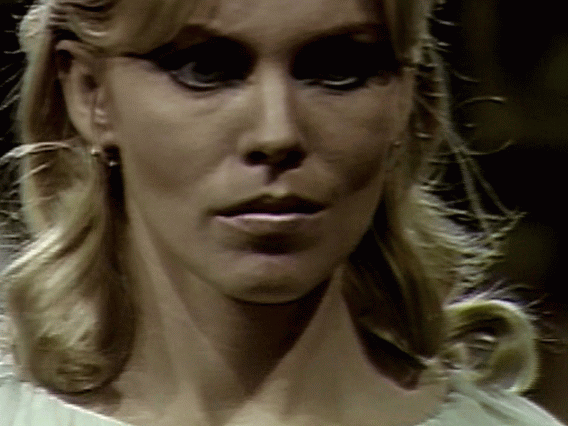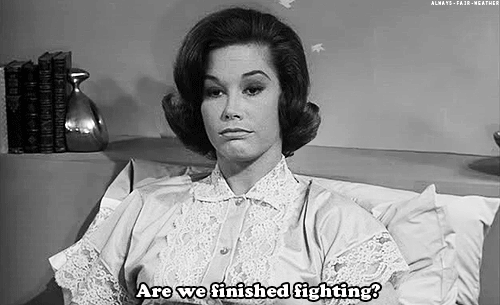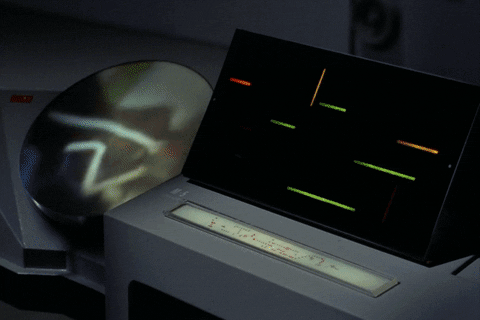FIVE-O YOUR ENTHUSIASM (INTRO)
By:
April 1, 2021
Each quarter, during 2021, HILOBROW will publish a 25-part “enthusiasm” series. Our 1Q2021 series, about cartoons, was: FERB YOUR ENTHUSIASM.
For our 2Q2021 series, I’ve invited 25 of HILOBROW’s talented contributors and friends to write about a favorite TV show from the cultural era known as the Sixties (1964–1973, in our periodization scheme.) The series title, FIVE-O YOUR ENTHUSIASM, is a tip of the hat to one of these shows.
Twenty of the 2Q2021 series installments have been submitted, as of this writing. These have inspired the brief introductory remarks offered below. The FIVE-O series kicks off this weekend.
Our contributors appreciate the unashamedly frivolous aspect of many of the shows from this era. Whether the genre is horror, espionage, or youthsploitation, here we find the TV version of the goofy “quickies” cranked out by Roger Corman, Alex Gordon, and other producers for American International Pictures, etc., during the Fifties (1954–1963). AIP’s formula, meanwhile, was originally a response to TV’s threat, so… full circle!

Lynn Peril, writing about Dark Shadows, recalls that at age nine, “the show’s campy erotica flew right over my head, but I tuned in for the adventures of Barnabas, Quentin (a sexy werewolf with his own memorable theme song), and Angelique (a witch once married to Barnabas).” Mark Kingwell, writing about The Man from U.N.C.L.E., marvels that the criminal league T.H.R.U.S.H.’s acronymic moniker “supposedly meant Technological Hierarchy for the Removal of Undesirables and the Subjugation of Humanity, which is, let’s face it, hilarious.” And David Smay, writing about The Monkees, revels in the fact that “Raybert Productions dug into that Marx Brothers strategy of making every joke a throwaway; they never leaned too hard on a punchline, and it didn’t matter if it landed. It conjured just the right airy soufflé of silliness.”
Even Sixties shows that make us cringe, now, because of an offensive premise are not entirely unenjoyable, for our contributors… precisely because they’re so over-the-top.
“There is so much about I Dream of Jeannie that is easy to criticize as toxically retro, from Jeannie’s insistence on calling Tony master to her skimpy outfit, to the fact that Tony could take away her power by putting the stopper back on her bottle when she was inside it,” notes Elizabeth Foy Larsen. However, she adds, “Even as a kid, those messages about a woman’s role in society were so hyperbolized that they didn’t make a mark on my psyche.” Writing about Hogan’s Heroes, meanwhile, Tom Nealon realizes that the German characters’ participation in their own doing “allowed kids like me to enjoy the show while kicking down the road — episode after episode — the whole question of whether it’s OK to enjoy the bumbling Nazis.”

Recalling her childhood experience of Gilligan’s Island, Peggy Nelson doesn’t find it offensive so much as harrowing. “The castaways never did escape the island,” she notes. “Those of us who grew up watching the show in reruns, on an endless loop, experienced it as a nightmare of eternal recurrence served up as an After-School PTSD Special.”
Fifties TV wasn’t politically engagé; Seventies TV was. Sixties TV is a bridge between the two eras — a bridge that spans the last black-and-white shows, c. 1964–1966, and the mainstreaming of shows shot in color. As I’ve written elsewhere about Sixties YA novels, the balancing act between cheerful, if shallow Fifties-ish fare and often right-on, if strident Seventies-ish fare is — at times, anyway — a marvel to behold.
“Given that Julia Baker was the first Black woman to come into many White Americans’ living rooms, it’s significant how much her on-screen world tried to keep the real one at bay, writes Adam McGovern of Julia. “Not by ignoring it — Julia regularly has to check some White character on their stereotyping or condescension — but by relentlessly portraying life as it should be, in benign good-humored sitcom terms.” Adrienne Crew, writing about Bewitched, categorizes it as a romantic comedy about a mixed marriage. “Samantha could have confessed to being African American or Jewish or a Muslim [i.e., instead of being a witch]. Feeling tricked, Darrin’s antipathy created conflict. Storylines echoed obstacles that mixed couples still face from hostile relatives and suspicious neighbors.”

Vijay Parthasarathy, writing about The Dick Van Dyke Show is particularly taken with the episode “My Part-Time Wife,” in which Laura, berating Rob for not hiring her as a typist “on the grounds that they likely wouldn’t work well as both marriage and business partners, exasperatedly pleads, ‘Darling, don’t you realize that in the office you would be the boss?’ That might sound like a tired sexist riff, but in 1964 it was ground-breaking to even implicitly suggest on TV that men weren’t masters of their fate.” And writing about The Patty Duke Show, Erin M. Routson, finds it poignant to think about the show as a metaphor for Duke’s own fragile mental health: “The lyrics to the song seem darker and more coded than they did when I was eight watching Nick at Nite — ‘What a crazy pair’, ‘you could lose your mind!'”
If Sixties TV was not particularly progressive, it at least revealed cracks in the façade of midcentury America’s dominant discourse. Sexual repression, the Protestant ethos, white privilege began to be questioned.

“Crime shows usually carry a conservative political edge, an us-and-them frame with the cops standing between the people and the lawless,” notes Gordon Dahlquist. But “Hawaii 5-0 portrays the ‘people’ in that dynamic as multi-ethnic and diverse, and American.” Sara Driver, writing about The Addams Family, recalls that married couples on TV, at that time, didn’t express their attraction to each other enthusiastically. “But Gomez would stand near Morticia, kissing her hair. Hearing her speak French, he’d run into the room, grab her arm and kiss up her arm to her neck, nuzzling and sniffing.” Miranda Mellis, writing about The Odd Couple, says: “There’s no need to ‘queer’ the show — it queers itself — but there’s another less obvious subtext here, about the gentile’s lost authority, his incompetence in the face of Oscar, a connoisseur of chaos, to whom he is indebted; with whom he is at odds.”
As retrogressive as these retro shows may be, in many ways, they could be eerily prescient.
“The visitors are arriving from a dying world; a common sci-fi trope by 1970, made all the more immediate by humanity’s contemporary collective realization that our planet might be on a similar trajectory,” writes Michael Grasso of the British show UFO. “With its often downbeat picture of a confusing new world and an atmosphere which is a defining example of the gloomy, haunted mood of 1970s British TV,” writes Richard McKenna, “Doomwatch remains hugely watchable, the overlap of power, money, science, conspiracy and manipulation which was its focus having revealed itself over the decades as perhaps the defining vector in modern life.”

Annie Nocenti, writing about Get Smart in the wake of Donald Trump’s presidency, finds the show’s central gag — it’s the US counterintelligence agency CONTROL versus the evil organization KAOS — a bit too on the nose. “In these maladroit times, lines like ‘No control agent can stand up to the logic and planning of chaos!’ no longer read as mirthful satire. They feel more spot-on than spoof.”
HILOBROW’s contributors don’t indulge in anything so odious as hate-watching, but as you’ll see they’ve found plenty to criticize in these shows. Still, I want to conclude these introductory notes by reminding our readers that this is an “enthusiasm” series. Each of these shows is one for which at least one of our writers feels a certain amount of fondness… a sentiment that can’t be entirely disentangled, of course, from nostalgia.

Michael Lewy, writing about Star Trek, notes that he has remained obsessed with its aesthetics since childhood: “The episode ‘The Ultimate Computer’ is a classic story of man versus machine; it does not end well. However, although all the plot is all too relevant today, I am primarily interested in the show’s main prop, the M-5 super-intelligent computer.” Luc Sante, writing about Secret Agent, recalls that “the series’ hallmarks are concision and weighted small talk. Somehow these — along with the allure of those exotic locales — spoke to me intensely when I was eleven.” “There was always an adult around, often more than one,” marvels Susan Roe, remembering her obsession with The Brady Bunch. “Is that what blended families were like? Or California households? Or architect dads? The show was a fascinating alternate universe…”
Carlo Rotella, a HILOBROW contributor to whom I often find myself compelled to give the last word, because he articulates my own tongue-tied sensibilities so perfectly, finds Mannix mostly unwatchable today. However, he can vividly recall being galvanized by a particular moment within the detective show’s opening montage. “It’s an exploded cubist rendition of a standard action shot, strange and pregnant with promise, mystery, invitation,” he writes. “I understood it to say Who cares why this fool is running again? Look at the world! Let’s go there.”

Here’s the series lineup:
Lynn Peril on DARK SHADOWS (1966–1971) | Mark Kingwell on THE MAN FROM U.N.C.L.E. (1964–1968) | Elizabeth Foy Larsen on I DREAM OF JEANNIE (1965–1970) | Luc Sante on SECRET AGENT/DANGER MAN (1964–1968 seasons) | Erin M. Routson on THE PATTY DUKE SHOW (1963–1966 run) | Gordon Dahlquist on HAWAII FIVE-O (1968–1973 seasons) | Annie Nocenti on GET SMART (1965–1970) | Sara Driver on THE ADDAMS FAMILY (1964–1966) | Carlo Rotella on MANNIX (1967–1973 seasons) | Adam McGovern on JULIA (1968–1971) | Mimi Lipson on THE MARY TYLER MOORE SHOW (1970–1973 seasons) | Josh Glenn on BATMAN (1966–1968) | Tom Nealon on HOGAN’S HEROES (1965–1971) | Miranda Mellis on THE ODD COUPLE (1970–1973 seasons) | Peggy Nelson on GILLIGAN’S ISLAND (1964–1967) | Susan Roe on THE BRADY BUNCH (1969–1973 seasons) | Michael Grasso on UFO (1970–1973) | Richard McKenna on DOOMWATCH (1970–1972) | Adrienne Crew on BEWITCHED (1964–1972) | Michael Lewy on STAR TREK (1966–1969) | Greg Rowland on THE PARTRIDGE FAMILY (1970–1973 seasons) | David Smay on THE MONKEES (1966–1968) | Vijay Parthasarathy on THE DICK VAN DYKE SHOW (1964–1966 seasons) | Carl Wilson on THE CAROL BURNETT SHOW (1967–1973 seasons) | Jessamyn West on EMERGENCY! (1972–1973 seasons).
Alas, we couldn’t cover all of our favorite shows. We regret, for example, not being able to include: ADAM-12, BONANZA, COLUMBO, THE DEAN MARTIN SHOW, FAMILY AFFAIR, GOMER PYLE USMC, GREEN ACRES, I SPY, IRONSIDE, LOST IN SPACE, McHALE’S NAVY, MISSION: IMPOSSIBLE, THE MOD SQUAD, MONTY PYTHON’S FLYING CIRCUS, THE MUNSTERS, MY FAVORITE MARTIAN, NIGHT GALLERY, THE PERSUADERS, THE PRISONER, THE RAT PATROL, THE SAINT, TARZAN, THAT GIRL, and THE WILD WILD WEST.
Enjoy!
NERD YOUR ENTHUSIASM (4Q2021): NERDING | ARDUIN | KLINGON CONFIDENTIAL | MAP INSERTS | TIME | & 20 other nerdy passions. SWERVE YOUR ENTHUSIASM (3Q2021): WARHOL’S WALT WHITMAN | 70, GIRLS, 70 | TYRAEL’S MIGHT | SHIRATO SANPEI | THE LEON SUITES | & 20 other never-realized cultural productions. FIVE-O YOUR ENTHUSIASM (2Q2021): DARK SHADOWS | MANNIX | GET SMART | THE ADDAMS FAMILY | I DREAM OF JEANNIE | & 20 other Sixties (1964–1973) TV shows. FERB YOUR ENTHUSIASM (1Q2021): STEVEN UNIVERSE | TOP CAT | REN & STIMPY | SHE-RA AND THE PRINCESSES OF POWER | DRAGON BALL Z | & 20 other animated series. CARBONA YOUR ENTHUSIASM (2020): “Sex Bomb” | “Going Underground” | “Soft South Africans” | “Typical Girls” | “Human Fly” | & 20 other Seventies (1974–1983) punk singles. KLAATU YOU (2020 weekly): ZARDOZ | METROPOLIS | DARK STAR | SINS OF THE FLESHAPOIDS | SOLARIS | & dozens of other pre-STAR WARS sci-fi movies. CONVOY YOUR ENTHUSIASM (2019): THE TAKING OF PELHAM ONE TWO THREE | ROLLERBALL | BLACK SUNDAY | SORCERER | STRAIGHT TIME | & 20 other Seventies (1974–1983) action movies. SERIOCOMIC (2019 weekly): LITTLE LULU | VIZ | MARSUPILAMI | ERNIE POOK’S COMEEK | HELLBOY | & dozens of other comics. TUBE YOUR ENTHUSIASM (2018): LOONEY TUNES | THREE STOOGES | THE AVENGERS | ROCKY & BULLWINKLE | THE TWILIGHT ZONE | & 20 other Fifties (1954–1963) TV shows. WOWEE ZOWEE (2018 weekly): UNISEX | UNDER THE PINK | DUMMY | AMOR PROHIBIDO | HIPS AND MAKERS | & dozens of other Nineties (1994–2003) albums. KLUTE YOUR ENTHUSIASM (2017): THE KILLERS | BANDE À PART (BAND OF OUTSIDERS) | ALPHAVILLE | HARPER | BLOW-UP | & 20 other Sixties (1964–1973) neo-noir movies. #SQUADGOALS (2017 weekly): THE WILD BUNCH | BOWIE’S BAND | THE BLOOMSBURY GROUP | THE HONG KONG CAVALIERS | VI ÄR BÄST! & dozens of other squads. GROK MY ENTHUSIASM (2016 weekly): THE THEORY AND PRACTICE OF LUNCH | WEEKEND | MILLION YEAR PICNIC | LA BARONNE EMILE D’ERLANGER | THE SURVIVAL SAMPLER | & dozens more one-off enthusiasms. QUIRK YOUR ENTHUSIASM (2016): “Tainted Love” | “Metal” | “Frankie Teardrop” | “Savoir Faire” | “Broken English” | & 20 other Seventies (1974–1983) new wave singles. CROM YOUR ENTHUSIASM (2015): DARKER THAN YOU THINK | THE SWORD IN THE STONE | OUT OF THE SILENT PLANET | THIEVES’ HOUSE | QUEEN OF THE BLACK COAST | & 20 other Thirties (1934–1943) fantasy novels. KERN YOUR ENTHUSIASM (2014): ALDINE ITALIC | DATA 70 | TORONTO SUBWAY | JOHNSTON’S “HAMLET” | TODD KLONE | & 20 other typefaces. HERC YOUR ENTHUSIASM (2013): “Spoonin’ Rap” | “Rapper’s Delight” | “Rappin’ Blow” | “The Incredible Fulk” | “The Adventures of Super Rhyme” | & 20 other Seventies (1974–1983) hip-hop songs. KIRK YOUR ENTHUSIASM (2012): Justice or vengeance? | Kirk teaches his drill thrall to kiss | “KHAAAAAN!” | “No kill I” | Kirk browbeats NOMAD | & 20 other Captain Kirk scenes. KIRB YOUR ENTHUSIASM (2011): THE ETERNALS | BLACK MAGIC | DEMON | OMAC | CAPTAIN AMERICA | & 20 other Jack Kirby panels.
